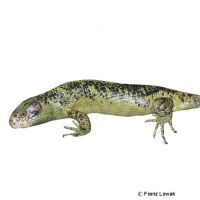Solomon Island Skink (Corucia zebrata)
| Solomon Island Skink Corucia zebrata | |
|---|---|
| Name | Solomon Island Skink |
| Name Lat. | Corucia zebrata |
| Family | Skinks |
| Family lat. | Scincidae |
| Order | Scaled Reptiles |
| Order lat. | Squamata |
| Origin | Solomon Islands |
| Habitat | Rainforests |
| Diet | Veggies, herbs, fruits |
| Humidity | 70-90 % |
| Behavior | Nocturnal, peaceful |
| Keeping | Pair, group |
| Care Level | Moderate |
| Reproduction | Ovoviviparous |
| Housing | Humid terrarium |
| Life Span | 15-20 years |
| Protection | CITES Appendix II; EU Annex B |
| Metric Units | |
| Size | 65-70 cm |
| Temperature | 28-30 °C |
| Housing Size | 150 x 100 x 180 cm |
| US Units | |
| Size | 26"-28" |
| Temperature | 82-86 °F |
| Housing Size | 60" x 40" x 70" |
Distribution and habitat
The tree-dwelling, crepuscular to nocturnal wrap-tailed skinks are native to the Solomon Islands, northeast of Australia. There, the skillful climbers live in the treetops of the tropical rainforests.
Maintenance
Minimum dimensions for the terrarium, according to the size and number of animals
| 1-2 animals | 4KRL x 3KRL x 5KRL (L x W x H) |
Head-torso length (KRL) is measured on the largest animal. For each additional animal, increase the footprint by 15%. A terrarium of e.g. 150 x 100 x 180 cm is recommended, which should be placed in a quiet and vibration-free place
They need a humid terrarium with high, thick climbing branches, a planting of Pandanus and stable Ficus, as additional climbing and hiding possibilities as well as structured back and side walls (e.g. cork lining) and a drinking trough fixed in the branches. Terrarium humus or a soil-peat mixture covered with some foliage and bark mulch is suitable as substrate. A large part of the substrate should be kept moist at all times. Several times a day the inside of the terrarium should be finely sprayed with water (humidity), but better is a rain or mist system
| Temp. day: 28-30 °C | Temp. night: 23-24 °C | Temp. local: --- | Humidity: 70-90 |
Thermostatically controlled floor heating is recommended. Lighting duration must be 12-14 hrs, depending on the season. Daylight fluorescent tubes are ideal.
Diet
The food offer consists mainly of vegetable food, such as various leaf salads, wild herbs (dandelion, ribwort, etc.) and fruit (bananas, apples, pears, berries, etc.). The leaves of ivy (Epipremnum or Scindapsus) are very popular. Ready-to-eat food for herbivorous reptiles is also often accepted. Occasionally they require animal protein in small amounts, such as grasshoppers, crickets, etc. It is important to add minerals and vitamins regularly (e.g. by dusting the food). Drinking water must always be available
A regular and varied diet promotes health and prevents deficiency symptoms.
Reproduction and breeding
The sexes are difficult to distinguish. The females are larger and somewhat more powerfully built. A reliable sex determination is only possible by testosterone determination or endoscopy.
They are viviparous (ovoviviparous) and a litter consists of 1-2 young, which are protected by the parents and remain together later in the family.
Life expectancy can be 15-20 years
Species protection
The animal population must be reported in writing to the competent authority immediately after the start of keeping. Subsequently, all arrivals and departures must be reported.
Protection of species: WA Annex II; EU Annex B. The proof of purchase is the required proof of origin for the animal. Please keep it safe! Your pet store will be happy to provide you with further information.
Important
Direct irradiation (sun or heat place) is not necessary. They are very peaceful animals with a strong sense of family. They have a strong and very mobile prehensile tail, with which they like to hang upside down
As pure tree dwellers they never come down to the ground, not even to feed. Therefore, also the daily food must be attached to the branches.
A hibernation period of about 2 months, with reduced lighting for 2-3 hours is recommended
The terrarium must have good ventilation without drafts and meet the species specific needs. Measuring devices such as thermometers, hygrometers, etc. are necessary. The lighting has to correspond to the species-specific day-night rhythm and has to be placed in such a way that the animals cannot injure themselves. The terrarium should be locked in such a way that neither unauthorized persons can open it nor the animals can escape. Contamination must be removed regularly
Further literature can be found in your pet store.
References
Text: petdata; Image: Franz Lowak
Source: BMELV (1997): Tierschutzgutachten - Mindestanforderungen an die Haltung von Reptilien; ENGELMANN (2006): Zootierhaltung - Tiere in menschlicher Obhut: Reptilien und Amphibien, Harri Deutsch Verlag
- Gemäß § 21 Abs. 5 Tierschutzgesetz idgF
